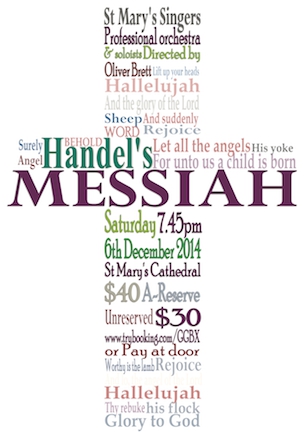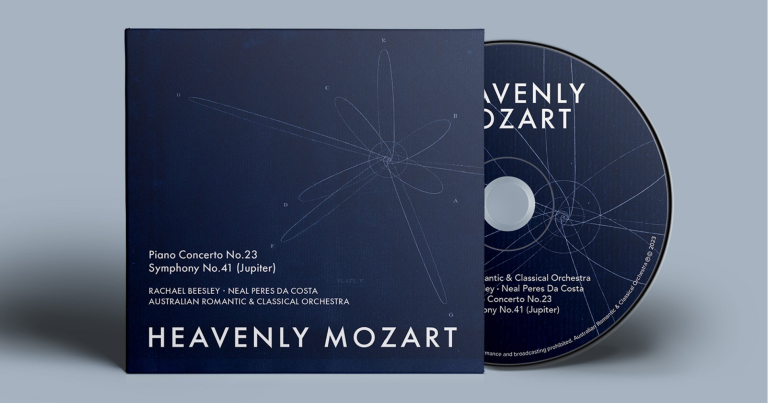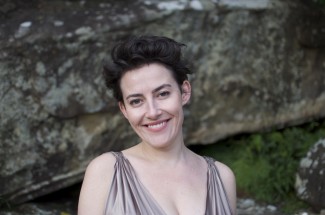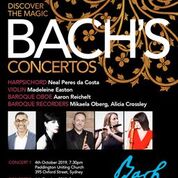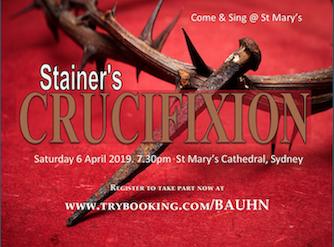Review: Handel’s Messiah/St Mary’s Singers
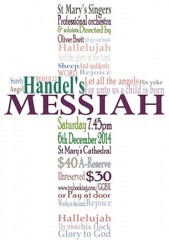
Handel: Messiah
St Mary’s Singers
St Mary’s Cathedral, Sydney
6 December 2014
Performances of Handel’s Messiah are a habitual prelude to the Christmas season, with presentations in churches and concert halls throughout the country. Musical styles are as varied as the performance locations, ranging from attempts to recreate original eighteenth century practices to massed performances with hundreds of singers.
The recent performance at St Mary’s cathedral was a middle-of-the road version with a choir of 70 singers and an orchestra of 21, mostly playing modern instruments. It was under the direction of Oliver Brett, the assistant director of music at St. Mary’s.
The cathedral has a notoriously difficult acoustic for concerts which include an orchestra. The reverberation time is very long and the sound from solo singers, who are usually placed at the crossing, tends to be swallowed up in the vastness of the building. Indeed, from half-way back in the nave the performers for this performance had to compete with recurring sirens and the sound of heavy rain outside. Much subtle detail was simply lost.
After a somewhat ponderous overture, Oliver Brett kept the work moving with some judicious cutting of numbers and with well-chosen, often spritely tempi. His gestures to the performers seemed to concentrate on time-keeping rather than subtlety of interpretation, and the acoustics did not help in maintaining synchronisation between choir and orchestra in some of the more complex passages.
The St Mary’s Singers is a mixed choir who are part of the wider musical establishment of the cathedral. They sang with conviction, though often with reduced confidence in the polyphonic sections. Numerically, the altos were the largest section but they also produced the least sound. The sopranos dominated the choral sound and the tenors, although few in number, made a satisfying contribution. A stronger bass line would have been desirable. The choir stood for most of the performance, although in the second half they briefly retreated the choir stalls for a short rest. Refreshed, they returned for a full-throated rendition of the Hallelujah chorus, which also provided the audience with a welcome opportunity to stand for a few minutes before resuming their seats on the cathedral’s penitential wooden pews.
Of the soloists, the tenor Damien Arnold and soprano Morgan Balfour were most successful in projecting their voices into the deeper recesses of the cathedral. Arnold has a bright, clear tenor sound that is well suited to Handel. He has only recently graduated from the Sydney Conservatorium and it will be interesting to see how this promising young singer develops in future. Morgan Balfour sang with an attractive, clear voice with a particularly bright upper register. She recently graduated from the Brisbane Conservatorium and will also be a singer to watch. The young baritone Benjamin Caukwell has a pleasant light voice but it does not have the weight of tone needed in sections such as ‘The people that walked in darkness’. Although more experienced than her younger colleagues, Nancy Long found that the low tessitura of the solo contralto part did not lie in a comfortable register for her voice. Her sound did not project very well into the middle of the cathedral, in spite of Oliver Brett ensuring that the orchestra was subdued when required. All the solo singers tried to apply eighteenth century practice with appoggiaturas and discreet ornamentation. However all of them also experienced occasional intonation problems, probably due to the strain of trying to project their voices into such a cavernous venue.
The orchestra included several key players from the Australian Chamber Orchestra and this experienced group produced a tidy, creditable performance, even if there were occasional suggestions that some of the players might have been almost sight-reading.
Mention must be made of John Foster’s fine trumpet solo in the bass aria ‘The trumpet shall sound’ where he used a natural trumpet. This was a good decision in cathedral’s resonant acoustic as the instrument’s lighter sound did not overpower the other performers. In the same aria is a pity that the singer missed an entry and the music was left hanging in the air for a time.
At the conclusion, the performance was enthusiastically applauded by the large audience which more than half filled the cathedral.
Larry for SoundsLikeSydney©
Larry Turner has been singing in choirs for many years – both in Sydney and London. He is an avid attender of operas and concerts, with an emphasis on vocal music. He particularly enjoys music from both the great a capella period and the baroque – especially the lesser-known works of Bach and Handel. He has written programme notes for Sydney Philharmonia, the Intervarsity Choral Festival and the Sydneian Bach Choir and is currently part of a team researching the history of Sydney Philharmonia for its forthcoming centenary.

